Delhi-Agra-Manali
Delhi-Agra-Manali
Honeymoon Cake
One Candle light Dinner
Cookies
Welcome drink
Complementary Van Vihar Ticket
- includes
- excludes
Things to do in and around kullu
How to reach kullu?
We've established convenient pickup and drop options right in your vicinity. Simply download the app, book your package using your location, and inform us of your exact whereabouts. Additionally, we've outlined various routes to reach the destination, taking into account commonly used traffic patterns.
Additional Information about Delhi-Agra-Manali
Delhi-Agra-Manali For enquiries
If you are looking to know more information about Delhi-Agra-Manali, our team at kullu will assist you personally through the below dedicated number
Delhi-Agra-Manali address
Delhi-Agra-Manali,
kullu,
himachalpradesh
Whatsplan's Delhi-Agra-Manali contact number : +91 9842067265
Places covered in(15)
Vaishno Devi Templekullu, himachalpradesh
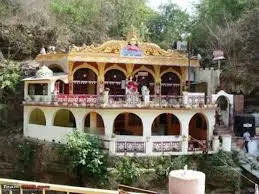
<p>The temple is located near Katra in the Trikuta Mountains of Jammu and Kashmir, India. Vaishno Devi Temple is one of the most revered and visited pilgrimage sites in India. Pilgrims undertake a trek to reach the sacred cave shrine of Mata Vaishno Devi.The temple is dedicated to Goddess Vaishno Devi, also known as Mata Rani. Devotees believe that a pilgrimage to the temple fulfills their wishes. Pilgrims typically undertake a trek of approximately 13.5 kilometers from Katra to reach the cave shrine. The trek passes through various points, including Banganga, Charan Paduka, Adhkuwari, and Sanjichhat. The cave shrine, known as the Bhavan, houses three natural rock formations called Pindis, representing the three manifestations of Goddess Mahalakshmi—Maha Kali, Maha Saraswati, and Maha Lakshmi. Regular aarti and pooja ceremonies are performed at the cave shrine, and devotees participate in these rituals with deep reverence. The festival of Navratra witnesses a significant influx of pilgrims to Vaishno Devi Temple. The period is considered auspicious for Mata Vaishno Devi's worship. Pilgrims need to register for the yatra (journey) to Vaishno Devi, and the Yatra Registration Counter is located in Katra. Vaishno Devi Temple is situated in the northern part of India, in the union territory of Jammu and Kashmir, it is quite a distance from Manali in Himachal Pradesh.</p>
Tibetan Monasterymanali, himachal_pradesh
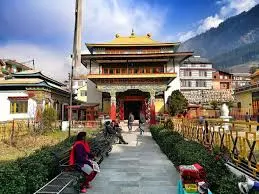
The Tibetan Monastery in Manali, Himachal Pradesh, is a significant religious and cultural landmark. The Tibetan Monastery is located in the heart of Manali, near the Mall Road. Its central location makes it easily accessible to visitors exploring the town. The monastery is characterized by traditional Tibetan architecture, featuring pagoda-style structures, vibrant colors, and intricate artwork. The design reflects Tibetan cultural influences. The Tibetan Monastery in Manali was built in the early 1960s by Tibetan refugees who had settled in the region. It serves as a place of worship and cultural preservation for the Tibetan community. The monastery is known for its exquisite Thangka paintings, which are traditional Tibetan scroll paintings depicting Buddhist deities, scenes, and symbols. Visitors can admire these intricate artworks. The monastery often has prayer wheels, cylindrical devices containing prayers or mantras. Devotees and visitors can spin the wheels, symbolizing the continuous recitation of prayers.Many Tibetan monasteries feature a central Buddha statue. The Manali Tibetan Monastery may house a prominent Buddha statue or other religious icons. The Tibetan Monastery is a hub for cultural activities, including religious ceremonies, rituals, and cultural events. Visitors may have the opportunity to witness or participate in these activities, depending on the timing of their visit. The monastery complex typically includes Tibetan handicraft shops where visitors can purchase traditional Tibetan artifacts, clothing, and souvenirs. The monastery provides a serene and tranquil atmosphere, making it a peaceful retreat for meditation or contemplation. In addition to its religious functions, the Tibetan Monastery serves as a community center for Tibetan refugees, fostering a sense of community and providing support services. The Tibetan Monastery in Manali is not only a religious site but also a cultural center that offers visitors a glimpse into Tibetan traditions and practices. It is a place of significance for both the local Tibetan community and tourists seeking to experience the rich cultural heritage of the region.
Solang Valleymanali, himachal_pradesh
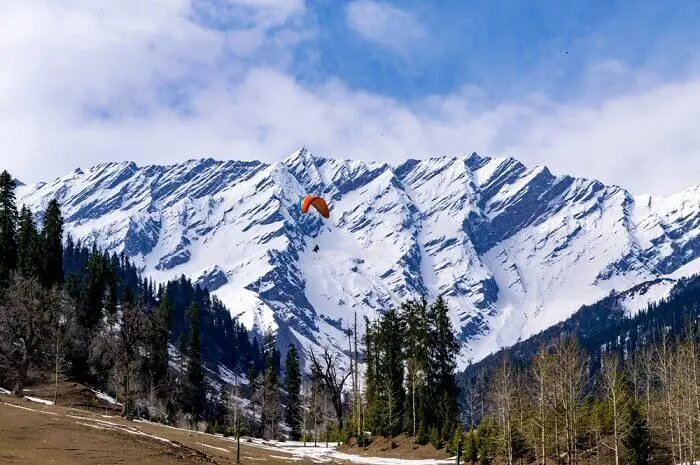
Solang Valley is situated about 14 kilometers northwest of Manali and is easily accessible by road. The valley lies on the way to Rohtang Pass. Surrounded by snow-capped peaks and lush greenery, Solang Valley offers stunning panoramic views of the Himalayas. The natural beauty of the valley attracts visitors throughout the year. During the winter, Solang Valley becomes a winter wonderland, attracting tourists looking to experience snowfall and engage in activities like snowboarding and building snowmen. There is a man-made ski lift in the valley, allowing visitors to reach higher points for skiing and snow-related activities. Solang Valley also offers opportunities for mountain biking, allowing adventure enthusiasts to explore the scenic landscapes on two wheels. The valley has a market where visitors can indulge in shopping for local handicrafts and souvenirs. There are also food stalls offering local and street food. Solang Valley is easily accessible from Manali by road. Taxis and private vehicles are commonly used to reach the valley.The weather in Solang Valley varies with the seasons. While it is covered in snow during winter, the summer months offer a pleasant climate for various outdoor activities. Solang Valley is a popular destination for skiing enthusiasts, especially during the winter season when the valley is covered in snow. The valley is known for its paragliding activities. Adventure seekers can experience the thrill of paragliding while enjoying aerial views of the valley. Zorbing involves rolling down a hill inside a giant transparent ball, providing a unique and fun-filled adventure. Visitors can enjoy a cable car ride that offers breathtaking views of the surrounding mountains. Solang Valley is not only a destination for adventure seekers but also a place where visitors can soak in the natural beauty of the Himalayas.
Hidimba Devi Templemanali, himachal_pradesh
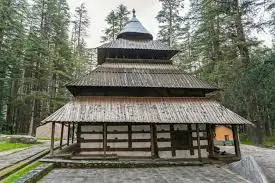
The Hidimba Temple is situated in the Dhungri Forest, about 2 kilometers away from the Mall Road in Manali. It is surrounded by tall deodar trees, adding to its natural beauty. The temple is dedicated to Hidimba Devi, a character from the Indian epic Mahabharata. Hidimba Devi is a goddess and the wife of Bhima, one of the Pandava brothers. One of the unique features of the Hadimba Temple is its architecture. It is built in the traditional pagoda style with a wooden exterior. The temple's intricately carved wooden facade showcases exquisite craftsmanship. The Hadimba Temple was built in 1553 by Maharaja Bahadur Singh, the ruler of Kullu. The temple has historical significance and is considered one of the oldest and most important temples in the region. The temple is a place of worship for the local people and attracts devotees and tourists alike. It holds cultural and religious significance in the Hindu faith. The Hadimba Temple is a focal point for various festivals, and special celebrations take place during Navratri. The temple comes alive with rituals, traditional music, and cultural activities during these times.The inner sanctum of the temple houses a footprint, believed to be that of Hidimba Devi. Devotees offer prayers and seek blessings at this sacred site. The temple is surrounded by lush greenery, creating a peaceful and serene environment. The natural beauty of the surroundings adds to the charm of the temple. The Hadimba Temple is located near the Manali Wildlife Sanctuary, providing an opportunity for visitors to explore the natural beauty of the region. The Hadimba Temple is not only a religious site but also a popular tourist attraction due to its architectural uniqueness and cultural significance. Visitors can enjoy the serene atmosphere and take in the beauty of the temple and its surroundings.
UNESCO World Heritage Sitemehrauli, delhi
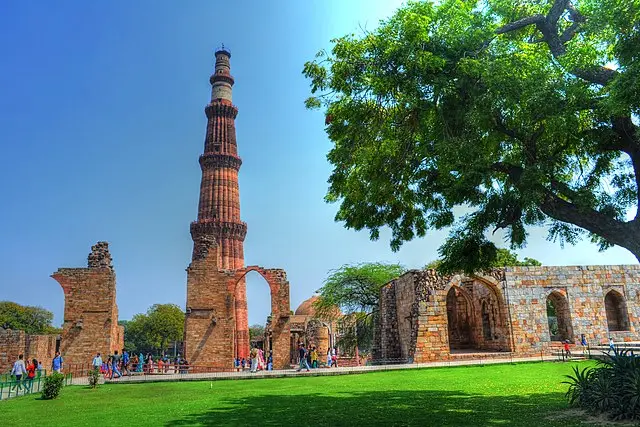
The Qutub Minar, a towering minaret, is the most iconic structure in Mehrauli and a prominent feature of the UNESCO World Heritage Site. Built by Qutb-ud-din Aibak in the early 13th century, the minaret stands at a height of 73 meters and is adorned with intricate carvings and verses from the Quran. It is a masterpiece of Indo-Islamic architecture. Adjacent to the Qutub Minar is the Quwwat-ul-Islam Mosque, one of the earliest mosques built in Delhi. The mosque incorporates materials from 27 Hindu and Jain temples, symbolizing the blend of Indo-Islamic architectural styles. Commissioned by Alauddin Khilji, the Alai Darwaza is an imposing gateway that stands near the Qutub Minar complex. It is known for its distinctive architectural features, including intricate carvings and a magnificent dome. Situated in the courtyard of the Quwwat-ul-Islam Mosque, the Iron Pillar of Delhi is a marvel of ancient metallurgy. It stands as a testament to the advanced technological skills of ancient Indian ironworkers. Despite being exposed to the elements for centuries, the iron pillar has not rusted. The tomb of Iltutmish, the second ruler of the Delhi Sultanate, is located within the Qutub Minar complex. It is an example of early Indo-Islamic funerary architecture and features a simple yet elegant design. Mehrauli is home to several other historical structures, including the Alai Minar (an unfinished tower), the Tomb of Balban, the Jamali Kamali Mosque and Tomb, and the Rajon Ki Baoli (a stepwell). Each of these monuments contributes to the UNESCO World Heritage Site's significance. The Mehrauli UNESCO World Heritage Site offers visitors a journey through centuries of history, showcasing the evolution of architecture and culture in the region. The complex is a popular destination for history enthusiasts, architects, and tourists seeking to explore Delhi's rich past.
Humayun's Tombnizamuddineast, delhi
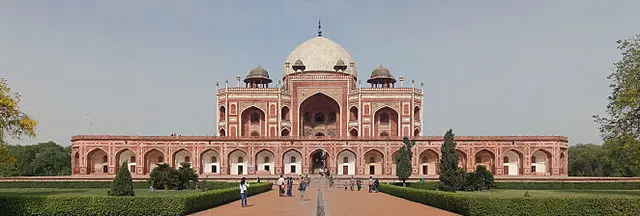
Humayun's Tomb is situated in the eastern part of Delhi, in the Nizamuddin East area. It is easily accessible from various parts of the city and is located near the Hazrat Nizamuddin Dargah. Built in the mid-16th century, Humayun's Tomb is a prime example of Mughal architecture and is considered a precursor to the Taj Mahal. The tomb was commissioned by Empress Bega Begum, the widow of Emperor Humayun, and it was designed by the Persian architect Mirak Mirza Ghiyas. The architectural style is a harmonious blend of Persian, Central Asian, and Indian influences. The tomb is set in a large garden divided into four squares by causeways and water channels, typical of the charbagh (four gardens) style. The main structure of Humayun's Tomb is a symmetrical garden tomb with a central octagonal chamber containing the cenotaph of Emperor Humayun. The tomb is made of red sandstone and white marble, creating a striking contrast. The central dome, chhatris (small pavilions), and intricate latticework showcase the elegance and grandeur of Mughal architecture. The tomb stands on a high platform and is approached by a grand staircase. The surrounding garden is divided into squares, each containing water channels and pathways. The garden layout reflects the Persian concept of paradise gardens. Humayun's Tomb holds historical significance as it is the final resting place of Emperor Humayun, the second Mughal ruler of India. The tomb also served as an inspiration for subsequent Mughal architectural masterpieces, including the Taj Mahal. In recent years, extensive restoration efforts have been undertaken to preserve and maintain the tomb and its surrounding gardens. These efforts have helped in showcasing the monument in its full glory and ensuring its longevity for future generations. Humayun's Tomb is a popular tourist destination, attracting visitors with its historical importance, architectural splendor, and serene surroundings. The tomb and its garden offer a peaceful escape from the bustling city, allowing visitors to explore and appreciate the beauty of Mughal architecture and landscaping.
Vashishtkullu, himachalpradesh
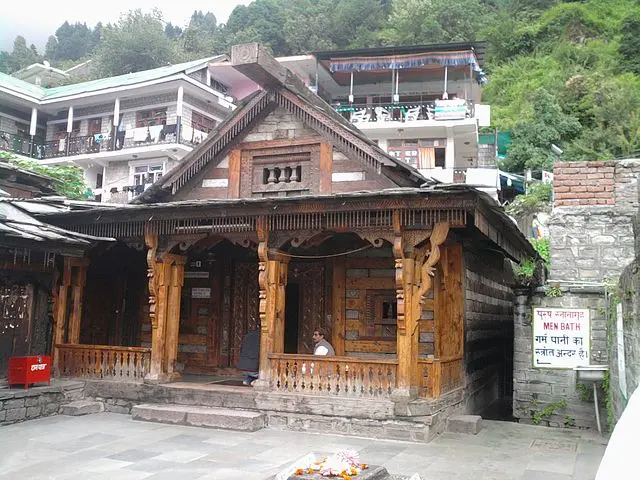
Vashisht is located approximately 3 kilometers from Manali, across the Beas River. It is easily accessible by road from Manali. Vashisht is renowned for its natural hot water springs with therapeutic properties. The village attracts visitors who seek relaxation and healing in the warm water of the springs. There are separate bathing areas for men and women. The village is home to the Vashisht Temple, dedicated to Sage Vashisht, one of the seven Chiranjivi (immortal beings) in Hindu mythology. The temple is known for its architectural style and historical significance. Surrounded by lush greenery and set against the backdrop of the Himalayan mountains, Vashisht offers stunning views of the natural landscape. The Beas River flows nearby, adding to the beauty of the surroundings. Vashisht is close to Old Manali, which is known for its charm and character. Old Manali has narrow lanes, traditional houses, and a vibrant atmosphere with cafes, shops, and guesthouses. The region around Vashisht and Manali offers various adventure activities, including trekking, paragliding, and river rafting. Adventure enthusiasts often use Vashisht as a base to explore the nearby trekking trails.Vashisht has a local market where visitors can shop for traditional Himachali handicrafts, woolens, and souvenirs. The village also has cafes and restaurants offering a variety of cuisines. Vashisht is well-connected by road from Manali, and visitors can easily reach the village by taxi or local transport. Manali is accessible by road from major cities in North India. The village celebrates various cultural and religious festivals, and visitors may have the opportunity to witness local rituals and festivities. Vashisht is known for its serene and peaceful atmosphere, making it a preferred destination for those seeking a tranquil retreat away from the hustle and bustle of city life.
Akshardhamnoidamor, delhi
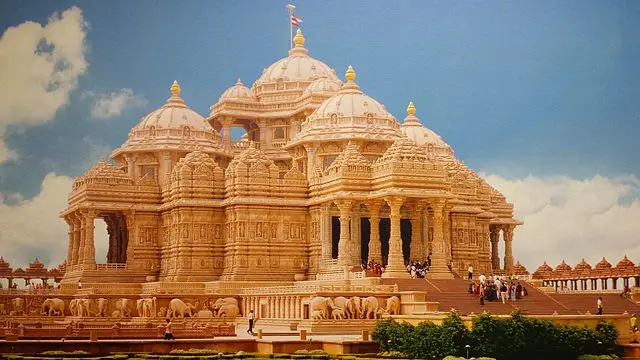
Akshardham is located in the neighborhood of East Delhi, near the Commonwealth Games Village, in the area known as Pandav Nagar. The temple complex was officially opened to the public on November 6, 2005. Akshardham is a masterpiece of architecture and showcases a blend of traditional Indian architectural styles. It features intricately carved sandstone and white marble. Akshardham is not just a temple; it is a cultural and spiritual campus that hosts a variety of activities, including cultural performances, exhibitions, and educational programs. The temple complex includes a beautifully landscaped garden representing the diverse flora of India. Visitors can take a boat ride that explores the ancient history and contributions of India's great personalities. Devotees can participate in the ritualistic bathing ceremony of the idols in the temple. Visitors can explore the intricacies of the temple's architecture and experience the serene atmosphere of the prayer hall. Due to its cultural and religious significance, Akshardham follows strict security measures. Electronic items, bags, and cameras are generally not allowed inside.The central monument is dedicated to Bhagwan Swaminarayan and houses a 3.2-meter high golden idol of Swaminarayan. The exhibition narrates the story of an ancient promise kept by the followers of Swaminarayan, and the water show depicts an episode from Swaminarayan's life. The largest stepwell in the world, Yagnapurush Kund features a musical fountain and the daily water show named "The Circle of Life."
ISKCON Temple newdelhi, delhi
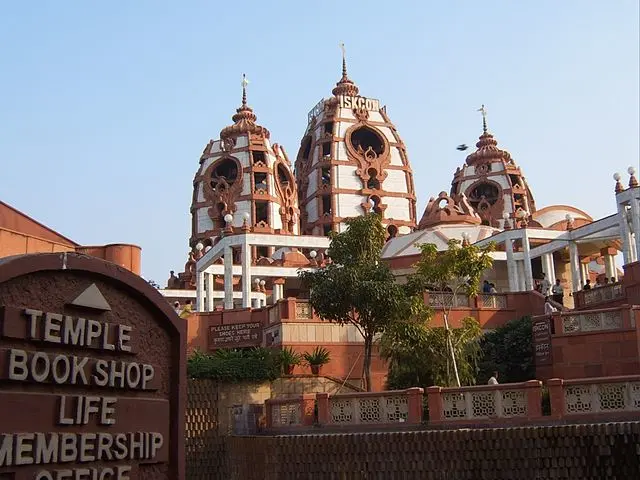
The ISKCON Temple is located in the Hare Krishna Hills, in the East of Kailash area of New Delhi, India. The temple is built in the style of ancient Indian architecture and is dedicated to Lord Krishna and his consort Radha. The temple complex includes the main temple building, a prayer hall, and various other facilities. The main deities worshiped in the temple are Sri Sri Radha Parthasarathi, which refers to Radha and Krishna together. The construction of the ISKCON Temple in New Delhi began in 1991, and the temple was officially opened to the public in 1998. It stands as one of the major spiritual and cultural landmarks in the city. The temple is known for its ornate and beautiful architecture, with intricate carvings and artwork. The interiors of the temple are adorned with paintings and sculptures depicting the life and teachings of Lord Krishna. The temple provides a peaceful and spiritual environment for prayer, meditation, and worship. Devotees and visitors often participate in bhajans (devotional songs) and kirtans (musical chanting of holy names).ISKCON New Delhi organizes various cultural and spiritual activities, including lectures, seminars, festivals, and cultural programs. The temple complex also includes a Vedic cultural center. The temple complex houses a vegetarian cafeteria that serves prasadam (sanctified food offered to deities), and a gift shop where visitors can purchase spiritual books, souvenirs, and other items. The temple celebrates major Hindu festivals with enthusiasm, and special events are organized during occasions like Janmashtami (the birth anniversary of Lord Krishna) and Radhashtami (the appearance day of Radha). The ISKCON Temple in New Delhi attracts a large number of devotees, tourists, and spiritual seekers from around the world.
Rohtang Passmanali, himachalpradesh
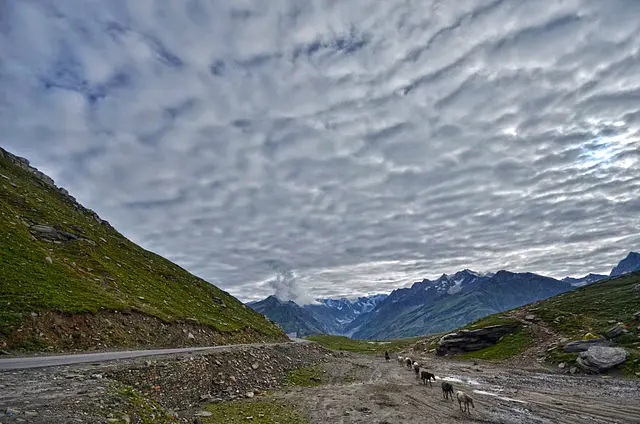
Rohtang Pass is situated at an elevation of approximately 3,978 meters (13,051 feet) above sea level. It is located about 51 kilometers from Manali and connects the Kullu Valley with the Lahaul and Spiti Valleys. The pass is a crucial route for travelers heading to Lahaul and Spiti regions. It is open to tourists from May to November, depending on weather conditions. Rohtang Pass is known for its breathtaking and snow-covered landscapes. The pass receives heavy snowfall during the winter months, and the surrounding peaks remain snow-clad for most of the year. The Solang Valley, known for its adventure sports activities, is often visited by tourists on their way to Rohtang Pass. Activities like paragliding, zorbing, and skiing are popular in Solang Valley. Rohtang Pass offers opportunities for adventure enthusiasts. Visitors can indulge in activities such as snow skiing, snowboarding, and snowmobiling during the winter months. The Beas Kund, the source of the Beas River, is located near Rohtang Pass. It is a popular trekking destination, and the trek provides stunning views of the surrounding peaks.Due to environmental concerns and to regulate vehicular traffic, permits are required for vehicles traveling to Rohtang Pass. These permits can be obtained in Manali. Located on the way to Rohtang Pass, Rahala Waterfalls is a picturesque spot where visitors can stop and enjoy the natural beauty. The journey to Rohtang Pass involves passing through the Jawaharlal Nehru Tunnel, which is the gateway to Lahaul and Spiti Valleys. The road to Rohtang Pass passes near the Great Himalayan National Park, known for its biodiversity and trekking trails. While Rohtang Pass itself is not near Chandratal Lake, travelers often use Manali as a base to explore this stunning high-altitude lake in the Spiti Valley.
Manikarankullu, himachalpradesh
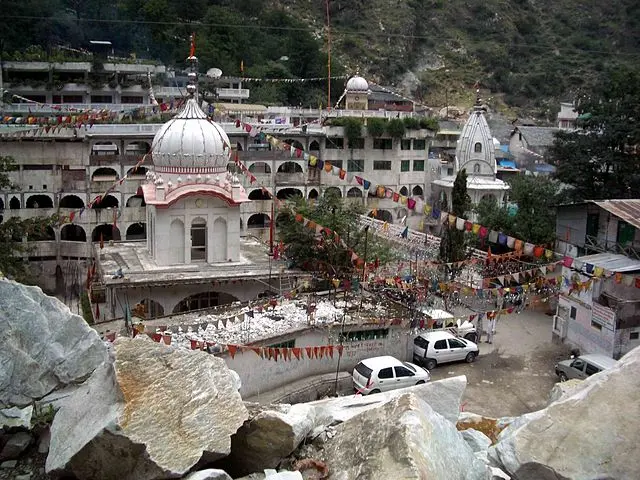
Manikaran is situated in the Parvati Valley, along the banks of the Parvati River. It is about 4 kilometers from Kasol and approximately 35 kilometers from Kullu. Manikaran is famous for its natural hot springs, which are believed to have therapeutic properties. The water in these springs contains various minerals, and taking a dip is considered auspicious by devotees. Manikaran is a significant pilgrimage site for both Sikhs and Hindus. There is a Gurudwara (Sri Guru Nanak Dev Ji Gurudwara) and a temple dedicated to Lord Shiva (Manikaran Sahib), making it a place of religious harmony. According to local legend, a demon once stole the earrings (mani) of Goddess Parvati, and Lord Shiva retrieved them by releasing a serpent. During this event, hot water sprang out of the ground, creating the hot springs. The Gurudwara in Manikaran is associated with Guru Nanak Dev Ji, the founder of Sikhism. It is a prominent Sikh pilgrimage site, and the langar (community kitchen) here serves free meals to visitors. The temple dedicated to Lord Shiva is another important religious site. It is believed that Lord Shiva meditated here.Manikaran is surrounded by scenic beauty, with the Parvati River flowing through the valley and the Himalayan mountains in the backdrop. The lush greenery and natural beauty make it a tranquil destination. Manikaran serves as a base for treks to nearby areas, including the famous trek to Kheerganga. The town is well-connected by road. The nearest airport is Bhuntar Airport in Kullu, and the nearest railway station is Joginder Nagar Railway Station. The place comes alive during festivals, and pilgrims visit in large numbers during important occasions.
Agra Fortagra, uttarpradesh
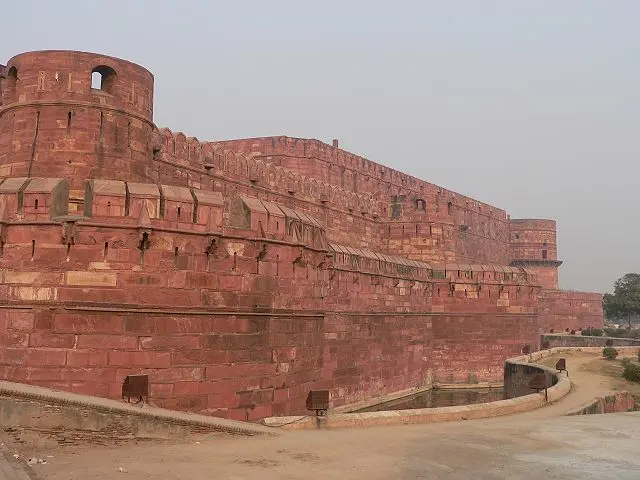
Agra Fort is situated in the city of Agra, on the banks of the Yamuna River. It is located near the iconic Taj Mahal. Agra Fort has immense historical significance and has been witness to various important events in Indian history. It served as the main residence of the emperors of the Mughal Dynasty until 1638 when the capital was shifted to Delhi. The fort reflects a mix of architectural styles, including Islamic, Persian, and Hindu elements. It is predominantly built with red sandstone. The construction of Agra Fort began in 1565 during the reign of Emperor Akbar and continued under subsequent Mughal emperors, including Shah Jahan. Agra Fort is a massive structure with walls that stretch for over two kilometers. It consists of various buildings and structures within its complex, including palaces, mosques, and audience halls. The palace was built by Emperor Akbar and later renovated by his son, Jahangir. It is known for its architectural beauty. The fort is famously associated with the imprisonment of Emperor Shah Jahan by his son Aurangzeb. Shah Jahan spent his last years looking at the Taj Mahal from a window in Agra Fort. Agra Fort offers stunning views of the Taj Mahal, and the fort itself is visible from the Taj Mahal. Agra Fort is open to tourists, and visitors can explore its various structures, halls, and gardens. The fort attracts millions of tourists each year. This is where the emperor would address the general public and hear their grievances.This was the private chamber for the emperor, where important discussions and meetings took place. A beautiful palace with intricate mirror work. A white marble mosque within the fort complex.
Raj Ghat newdelhi, delhi
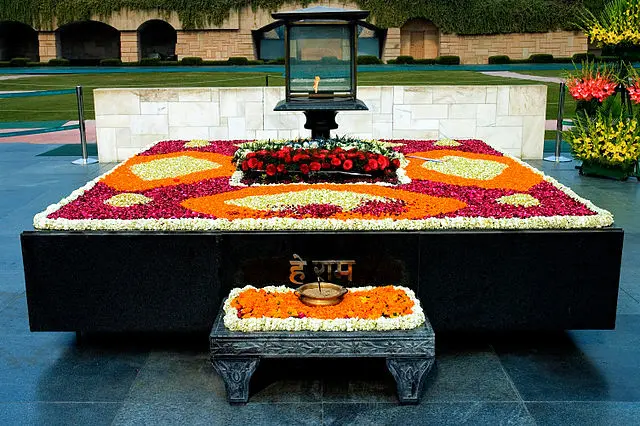
Raj Ghat is situated on the banks of the Yamuna River, near Ring Road in Delhi. It is a prominent historical site and a popular destination for both tourists and locals. The memorial is a simple black marble platform that marks the spot where Mahatma Gandhi was cremated on January 31, 1948, a day after his assassination. The design reflects the simplicity and humility that Gandhi advocated throughout his life. At the center of the memorial, there is an eternal flame that symbolizes the enduring spirit of Mahatma Gandhi's principles and teachings. The Raj Ghat Samadhi Committee is responsible for the maintenance and preservation of the memorial. The committee organizes events and ceremonies on significant occasions. Near Raj Ghat, there is a museum called Gandhi Smriti, which was the residence of Mahatma Gandhi during the last 144 days of his life. Visitors can explore the museum to learn more about Gandhi's life and philosophy. Raj Ghat attracts visitors from around the world who come to pay their respects to Mahatma Gandhi. It is a place of reflection, meditation, and reverence.Mahatma Gandhi was assassinated on January 30, 1948, at Birla House (now Gandhi Smriti). After his assassination, his body was brought to Raj Ghat for cremation.The memorial is surrounded by beautiful gardens that add to the serenity of the place. The lush greenery and quiet atmosphere make it a peaceful location. Adjacent to the memorial, there is an open-air prayer ground where prayer meetings are occasionally held to honor Mahatma Gandhi's memory. Raj Ghat is a site where national leaders, dignitaries, and the general public gather on significant days such as Gandhi Jayanti (October 2) to pay homage to Mahatma Gandhi.
Lotus Templedelhi, delhi
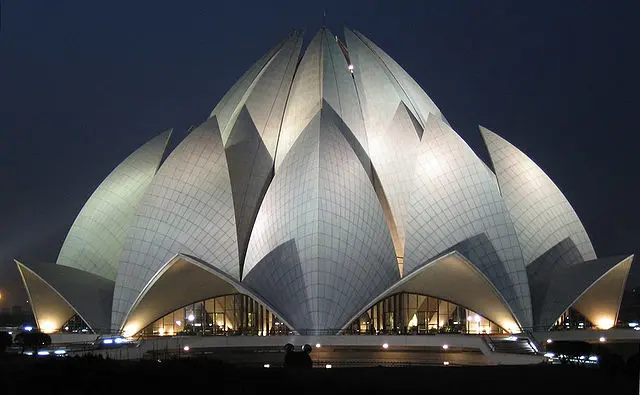
The Lotus Temple is situated in the southern part of Delhi, in the neighborhood of Kalkaji. It is positioned near the Nehru Place business district and is easily accessible from various parts of the city. Designed by Iranian architect Fariborz Sahba, the Lotus Temple is renowned for its distinctive lotus flower-inspired architecture. The structure is composed of 27 free-standing marble-clad "petals" arranged in clusters of three to form the shape of a lotus blossom. These white marble petals are surrounded by nine pools of water, giving the illusion that the lotus is floating, and creating a visually stunning effect. The temple is an exquisite example of modern Indian architectural design. The Lotus Temple is the foremost Bahá'í House of Worship in the Indian subcontinent. It is open to people of all faiths, welcoming visitors from around the world to meditate, pray, or simply enjoy the serene surroundings. The Bahá'í Faith emphasizes the oneness of God, the unity of all religions, and the unity of humanity. The central hall of the Lotus Temple is a large, open space devoid of religious symbols or images. It is meant to be a place for silent meditation and prayer. The temple does not have any idols, altars, or clergy. Visitors are encouraged to reflect on their spiritual thoughts in a tranquil atmosphere.Surrounding the Lotus Temple are well-maintained gardens that enhance the overall beauty of the site. The landscaping is designed to complement the lotus theme, creating a peaceful and contemplative environment for visitors. The temple is often illuminated in the evenings, presenting a breathtaking sight against the darkening sky. In addition to its role as a House of Worship, the Lotus Temple serves as a center for community service, education, and social development. It hosts various events, discussions, and activities aimed at promoting unity and understanding among people of different backgrounds. The Lotus Temple is a popular tourist attraction and has won numerous architectural awards. Visitors are not only captivated by its unique design but also by the spiritual and serene atmosphere it offers. It stands as a symbol of India's religious diversity and the inclusivity that is a core principle of the Bahá'í Faith.
Kasolkullu, himachalpradesh
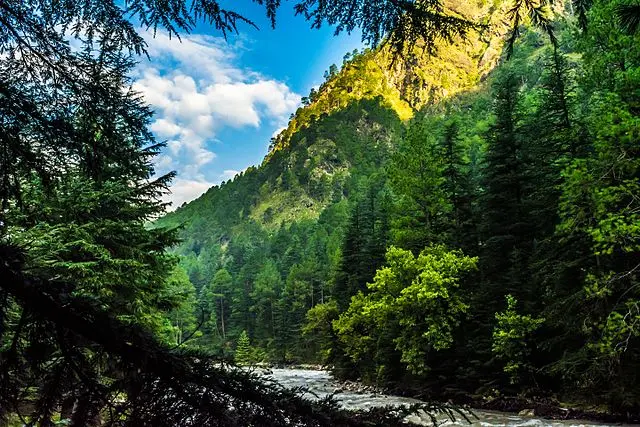
Kasol is situated along the banks of the Parvati River in the Parvati Valley. It is approximately 42 kilometers east of Kullu and about 5 kilometers from Manikaran.Natural Beauty isKnown for its breathtaking landscapes, Kasol is surrounded by lush green hills, dense forests, and the majestic Parvati River. The area is often referred to as "Mini Israel" due to the significant number of Israeli tourists who visit the region. Kasol serves as a popular base for treks to nearby destinations, including Kheerganga, Malana, Tosh, and Grahan. The treks offer stunning views of the Himalayan peaks and provide an opportunity to explore the pristine beauty of the region. Kasol is home to numerous cafes and restaurants that offer a diverse range of cuisines, including Israeli, Italian, and local Himachali dishes. The laid-back atmosphere and scenic surroundings make these places perfect for relaxation. The local market in Kasol offers a variety of items, including traditional Himachali handicrafts, woolens, and souvenirs. It's a great place to explore and shop for unique items. Nearby Manikaran is known for its hot springs, and visitors often take a short trip to experience the natural hot water baths with therapeutic properties. Kasol offers camping options along the riverbanks, providing a close connection with nature. Adventure enthusiasts can also indulge in activities like river rafting, rock climbing, and trekking. Kasol is a starting point for treks to the ancient village of Malana, known for its distinct customs, language, and the cultivation of Malana Cream, a famous strain of cannabis. Kasol hosts various music festivals throughout the year, attracting music enthusiasts from different parts of the country. The nearest airport is Bhuntar Airport in Kullu, and the nearest railway station is Joginder Nagar Railway Station. Kasol is well-connected by road, and buses and taxis are available from major nearby cities.